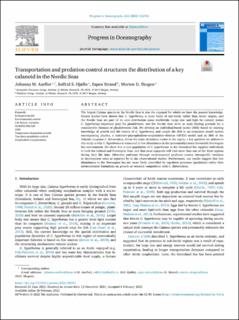Transportation and predation control structures the distribution of a key calanoid in the Nordic Seas
Peer reviewed, Journal article
Published version
Permanent lenke
https://hdl.handle.net/11250/3014632Utgivelsesdato
2022Metadata
Vis full innførselSamlinger
- Articles [3011]
- Publikasjoner fra CRIStin [3061]
Sammendrag
The largest Calanus species in the Nordic Seas is also the copepod for which we have the poorest knowledge. Recent studies have shown that C. hyperboreus is more likely of sub-Arctic rather than Arctic origins, and the Nordic Seas are part of its core distribution areas worldwide. Large size and high fat content makes C. hyperboreus important prey for planktivores, and the Nordic Seas serve as main feeding grounds for a considerable biomass of planktivorous fish. We develop an individual-based model (IBM) based on existing knowledge of growth and life history of C. hyperboreus, and couple the IBM to an ecosystem model system encompassing physics, a nutrients–phytoplankton–zooplankton–detritus (NPZD) model and an IBM of the Atlantic congener C. finmarchicus. Given the main circulation routes in the region, a key question we address in this study is why C. hyperboreus is measured in low abundances in the (presumably) more favourable Norwegian Sea environment. We show that a core population of C. hyperboreus in the Greenland Sea supplies individuals to both the Iceland and Norwegian Seas, and that most copepods will visit more than one of the three regions during their life time. Advective pathways through environmental gradients creates intraspecific variation in development rates as reported by in situ observational studies. Furthermore, our results suggest that low abundances in the Norwegian Sea are more likely controlled by top-down processes (predation) rather than environmental limitations on growth or resource competition with C. finmarchicus.
